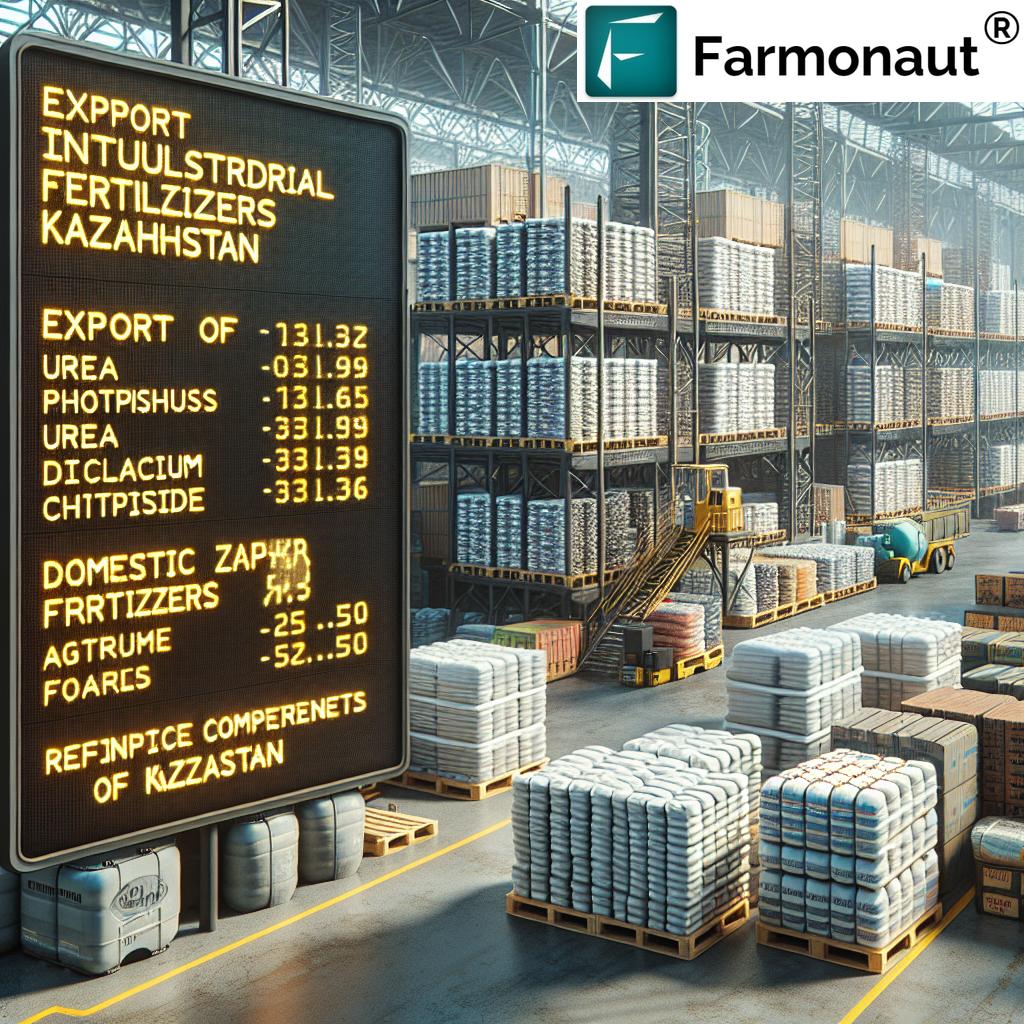7 Key Trends Fueling Fertilizer Growth in Kazakhstan’s Chemical Industry
“In 2023, Kazakhstan’s fertilizer production surged by over 15%, strengthening its position in the global chemical industry.”
“Kazakhstan aims to double fertilizer exports by 2025, driven by government-backed industrial diversification initiatives.”
Introduction: Kazakhstan’s Fertilizer Production Surge
The Kazakhstan chemical industry is undergoing a remarkable transformation, positioning itself as a regional powerhouse in fertilizer production. In an era where food security and industrial independence are vital, Kazakhstan’s advances in manufacturing, export, and innovation are rewriting the regional economic narrative.
Our nation’s commitment to agricultural sector development Kazakhstan, fueled by robust policy initiatives, has led to an annual average growth of 5% in the chemical sector over the last five years, with 2023 alone witnessing a 15% surge in fertilizer output.
This upward trajectory not only supports local agriculture but is also enhancing industrial diversification in Kazakhstan, boosting exports, and consolidating strategic priorities for 2030 and beyond.
Let us explore the seven key trends shaping the growth of fertilizer production in Kazakhstan and how these developments are charting a forward-thinking path for the country’s chemical and agricultural industries.
1. Government Measures and Policy Support: Backbone of Kazakhstan Chemical Industry Growth
One of the cornerstones of chemical industry growth Kazakhstan is the government’s robust, multi-layered policy framework. The Ministry of Industry and Construction, led by Minister Yersaiyn Nagaspayev, has prioritized the diversification of the economy and enhanced self-sufficiency in both the agricultural and industrial sectors. These efforts are evident in several strategic initiatives:
- Raw Materials Exemption: The government has implemented VAT exemptions on raw materials for the production of pesticides, boosting local manufacturers and lowering the cost base for chemical producers.
- Export Regulation: Introduction of exclusive export rights for ammonium phosphate and ammonium nitrate—vital measures preventing illegal exports and stabilizing domestic prices.
- Subsidies & Price Stabilization: Regulatory tools and fiscal support aimed at minimizing the impact of global price volatility on the domestic market.
- Production Targets: Ambitious national targets for urea, ammonium phosphate, potassium chloride, and dicalcium phosphate are set to cover at least 80% of national demand by 2030.
These measures underscore the central role of policy in driving the fertilizer production in Kazakhstan and maintaining the country’s competitive edge in the region.
2. Expansion of Domestic Fertilizer Production in Kazakhstan
A defining attribute of the current landscape is the exponential growth in domestic fertilizer production Kazakhstan. In 2023, production volume exceeded 1 trillion tenge (US$1.9 billion), propelled by:
- Major Enterprises: Industry leaders such as KazAzot, Kazphosphate, Kaustik, and Atyrau oil refinery have been pivotal in scaling output to meet rising domestic demand and support export potential.
- Product Diversity: The sector produces a comprehensive suite including fertilizers, pesticides, phosphates (notably ammonium phosphate), chromium compounds, calcium carbide, paints, household chemicals, automotive chemicals, and lubricants.
- Volume Growth: In the first quarter of 2024 alone, the output grew to 406 billion tenge (approx. US$785 million) marking a 12.5% increase year-on-year—demonstrating the resilience and adaptability of the industry.
- National Targets by 2030: Production plans are in place for 1.5 million tons of ammonium phosphate, 800,000 tons of urea, 700,000 tons of potassium chloride, and 300,000 tons of dicalcium phosphate, ensuring most of the agricultural sector’s nutrient requirements are fulfilled domestically.
The expansion of fertilizer production in Kazakhstan is thus closely aligned with food security objectives and is essential for the development of agriculture and allied industries.
3. Focus on Industrial Diversification and Export Potential
Industrial diversification in Kazakhstan is a deliberate strategy to reduce dependency on oil and create a resilient economy. The chemical sector, with a 4.6% share of the manufacturing industry, acts as an engine for:
- Segmental Growth: Boosting value-added sectors like metallurgy and building materials by supplying essential raw materials, chemicals, and compounds (e.g., sodium cyanide, chromium compounds, calcium carbide).
- Export Potential: With production capacity enhancements, export of fertilizers Kazakhstan is set to almost double by 2025, leveraging demand from international markets, especially in Central Asia and beyond.
- Employment Generation: The expansion of fertilizer plants and related industries is creating jobs and encouraging development in regions such as Astana and other economic hubs.
- Stabilizing Prices: Exclusive export regimes prevent unauthorized exports, keeping domestic prices stable—which is crucial for food systems and farmers’ profitability.
By nurturing downstream linkages, the Kazakhstan chemical industry is stimulating economic activity and fostering industrial self-reliance.
Transparency and product authenticity are vital for building global trust in Kazakhstani exports. Explore
Farmonaut’s blockchain-based traceability solutions. These enhance supply chain transparency for exporters and agribusinesses seeking international markets.
“In 2023, Kazakhstan’s fertilizer production surged by over 15%, strengthening its position in the global chemical industry.”
4. Advancements in Product Innovation and Technology Transfer
Fertilizer production in Kazakhstan is not limited to volume but is evolving in complexity and quality, driven by innovation in processes and products:
- High-Efficiency Fertilizers: Adoption of advanced manufacturing technologies is yielding products such as granular urea, specialized NPK blends, and slow-release fertilizers for enhanced soil efficiency.
- Phosphorus and Potassium Fertilizers: Expanded investments in the ammonium phosphate market and development of potassium chloride facilities ensure greater domestic availability of essential crop nutrients.
- Process Automation: Digital transformation, with increased use of AI and process analytics, is leading to better quality control and lower wastage across plants in Astana and beyond.
- R&D Collaboration: Partnerships with research institutions and global technology providers allow for transfer of latest manufacturing techniques, especially in areas like sodium cyanide and yellow phosphorus production.
Such continued improvements position the Kazakhstani industry as a modern, competitive producer aligning with international quality standards.
Sustainability is central to innovation. Learn about
Farmonaut’s carbon footprint tracking, which allows agribusinesses to monitor and reduce emissions—meeting international compliance and sustainability goals.
5. Coal Chemistry Kazakhstan: Leveraging Vast Reserves for Fertilizer Innovation
The immense national reserves of coal are opening new pathways in chemical production, with coal chemistry Kazakhstan emerging as a promising field:
- Investment in Coal-based Fertilizers: State strategy prioritizes the development of plants using coal as a feedstock for the synthesis of ammonia and urea, key agricultural nutrients. Collaborations with global engineering giants are underway to establish modern, large-scale facilities.
- Value-Added Materials: Coal mining enterprises, in collaboration with scientific institutes, are innovating to extract chemicals for fertilizers, absorbents, nanomaterials, and even diesel fuel—broadening the chemical sector’s portfolio.
- Resource Security: Utilizing local coal bolsters national supply chain security and insulates the industry from international energy and input market shocks.
- Strategic Partnerships: By engaging with engineering leaders and leveraging research expertise, Kazakhstan is positioning itself at the cutting edge of the “coal-to-chemicals” global trend.
This move not only accelerates industrial diversification in Kazakhstan but also enhances the country’s standing as an integrated energy and agri-chemicals player.
6. Integration of Advanced Technologies in Farming and Resource Management
The confluence of digital transformation in farming and advanced chemical products is producing far-reaching benefits for Kazakhstan’s agricultural sector development:
- Precision Agriculture: Adoption of satellite-based, data-driven agriculture is allowing farmers and agribusinesses to optimize fertilizer usage, crop yields, and monitor resource efficiency.
- Resource Management: Enhanced deployment of IoT, sensors, and satellite data supports better planning for irrigation, crop health assessments, pesticide interventions, and resource allocation.
- Decision Support Systems: AI-based platforms provide real-time advisory and risk management insights, decreasing input waste and enabling sustainable yields.
These digital solutions are increasingly necessary for ensuring the success of fertilizer production in Kazakhstan, enhancing traceability, and safeguarding returns for both local and international stakeholders.
To maximize farm productivity, Farmonaut’s large-scale farm management app offers powerful satellite-based monitoring and decision support for businesses overseeing vast agricultural holdings.
7. Sustainable Growth and Food Security as Strategic Priorities
No overview is complete without recognizing Kazakhstan’s resolve toward sustainable development and food security. The chemical industry’s growth is orchestrated to meet the comprehensive nutrient demand of Kazakhstan’s domestic agriculture sector by 2030. Key focus areas include:
- Domestic Self-Sufficiency: Strategic plans ensure the country meets nearly all of its requirements for nitrogen, phosphorus, and potassium fertilizers through domestic production.
- Input Subsidization: Government programs help lower the cost of fertilizers and critical chemicals for farmers, promoting widespread adoption and sustained yield improvements.
- Environmental Stewardship: Emphasis on sustainable mining of phosphates and potassium, coupled with investments in waste minimization and green chemistry across industrial plants in Astana and other cities.
- Capacity Building: Research, training, and skill-building initiatives for local talent ensure that human capital development keeps pace with technological progress.
These steps ensure that the Kazakhstan chemical industry not only supports agricultural productivity but does so while supporting the country’s sustainability and food sovereignty goals.
Optimizing access to finance and insurance is vital. With Farmonaut’s satellite-based crop loan and insurance verification tools, farmers and financial institutions can reduce fraud and unlock secure credit for agricultural expansion.
Trends Comparison Table: Fertilizer Industry Growth Kazakhstan
| Trend Name | Description | Estimated Growth Rate (2020–2024) | Key Drivers | Relevant Government Initiatives | Projected Impact on Exports |
|---|---|---|---|---|---|
| Policy & Government Support | Comprehensive regulatory and fiscal backing for chemical sector growth and price stabilization | 5–8% annual | VAT exemptions, export controls, subsidies | VAT exemption on raw materials, export monitoring, stabilization funds | Stable supplies ensure export commitments; prevents illegal exports |
| Domestic Production Expansion | Scaling fertilizer, phosphate & nitrogen outputs to support domestic agriculture and industry | 12–15% in 2023 | Capacity additions, plant upgrades | 2023–2030 national targets for urea, ammonium phosphate, dicalcium phosphate, potassium chloride | Reduces imports, increases exportable surplus by 2025 |
| Industrial Diversification | Movement of the economy from oil-centric to multi-sectoral growth, leveraging chemicals | 5% annual (sectoral average) | Downstream value addition, job creation | Economic diversification policies, enterprise support | Expanded product portfolio increases export markets |
| Product & Technology Innovation | Adoption of advanced processes for efficiency and higher-quality products | 6–10% in high-value segments | R&D, technology transfer, digitalization | Technology grants, R&D tax incentives | Improved global competitiveness; compliance with standards |
| Coal Chemistry Development | Harnessing coal for production of ammonia, urea and specialized materials | 4–7% sectoral | Leveraging natural resources, engineering expertise | Project support, research partnerships | Resource-based exports; diversified portfolio |
| Digital Transformation | Use of satellite data, AI, and digital tools for farm and fertilizer application optimization | 7–12% productivity gains | Precision ag, IoT, big data | Support for agri-tech pilot programs | Enables traceable, value-added export products |
| Sustainable Growth & Food Security | Aligning industry growth with national food self-sufficiency and eco-targets | Target: 80%+ coverage of domestic demand by 2030 | Sustainability mandates, farmer support | Subsidies, research in eco-friendly mining & waste reduction | Secures food exports; builds global reputation for sustainability |
Efficient distribution and timely delivery are crucial to fertilizer supply chains. Discover Farmonaut’s fleet management tools—these enable agricultural enterprises to minimize logistics costs and maximize operational efficiency.
Experience precision advisory at your fingertips with Farmonaut’s AI-powered crop advisory Jeevn. Receive real-time weather and crop management tips via Farmonaut app, available across platforms.
Access Farmonaut APIs for Advanced Agricultural Data
Developers and enterprises can seamlessly integrate satellite and weather data into their own digital solutions. Explore the Farmonaut API and comprehensive API Developer Documentation for technical specifications and onboarding resources.
Farmonaut Subscription Plans
Farmonaut: Empowering Precision Agriculture in Kazakhstan and Beyond
As fertilizer production in Kazakhstan accelerates, the value of precision agriculture and resource optimization grows. Farmonaut offers satellite-driven solutions to help farmers and agribusinesses make informed, data-backed decisions—be it crop health monitoring, AI-based advisory, blockchain traceability, or resource management.
- Satellite Crop Health Monitoring: Real-time, high-resolution NDVI and soil moisture maps empower farmers to optimize fertilizer and pesticide application, reducing wastage and increasing yields.
- Jeevn AI Advisory System: Custom crop management strategies and weather forecasts tailored for Kazakhstan’s unique climatic zones.
- Blockchain Traceability: Ensures product quality and origin transparency, vital for export of fertilizers Kazakhstan and agricultural products.
- Resource and Fleet Management: Optimizes distribution and tracks assets across Kazakhstan’s vast agricultural landscapes.
- Carbon Footprint Tracking: Assists in environmental compliance and sustainable farming practices.
Our vision aligns with Kazakhstan’s goals for digital transformation, export leadership, and sustainable development in the chemical industry—positioning the country as both an agricultural and technological leader.
Frequently Asked Questions (FAQ) on Kazakhstan’s Chemical Industry & Fertilizer Trends
- How significant is the Kazakhstan chemical industry in manufacturing?
As of the latest reports, the chemical sector contributes 4.6% to Kazakhstan’s manufacturing industry, with a marked impact on agriculture, metallurgy, and building materials. - What are the main fertilizer products manufactured domestically?
Core focus areas include ammonium phosphate, urea, potassium chloride, and dicalcium phosphate, among others. - How is Kazakhstan addressing food security and self-sufficiency?
By 2030, the country aims to meet all its requirements for nitrogen, phosphorus, and potassium fertilizers via domestic production, underpinned by state-backed capacity expansion and R&D. - What policy measures are supporting chemical sector growth?
Key actions include VAT exemptions on raw materials, export controls on select fertilizers to defeat illegal exports, and investments in advanced manufacturing technologies. - What role does digital agriculture play in Kazakhstan’s fertilizer strategy?
Digital platforms help optimize fertilizer application, crop health monitoring, and traceability, promoting productivity and sustainability at all scale levels. - How will coal chemistry affect Kazakhstan’s fertilizer industry?
Leveraging domestic coal reserves enables the production of high-demand chemicals like ammonia and urea, strengthening industrial diversification and export capabilities. - How can Farmonaut help Kazakhstani farmers and agribusinesses?
Farmonaut delivers remote crop monitoring, AI-driven advice, blockchain-backed supply chain traceability, carbon footprint monitoring, and efficient resource management—making precision agriculture affordable and scalable across the region.
Conclusion: Kazakhstan’s Fertilizer Industry—A Key Pillar for Future Growth
At the intersection of policy, technology, and resource stewardship, Kazakhstan’s chemical industry stands as a beacon for sustainable, inclusive growth. From government support to innovations in domestic fertilizers Kazakhstan, the sector’s trajectory is clear: empower agriculture, diversify industry, and secure export-driven economic resilience.
Digital solutions such as those from Farmonaut complement these advances—enabling precision, transparency, and traceability for both the nation’s farmers and agribusinesses.
As we look to 2030 and beyond, the continual collaboration between policy-makers, industry, farmers, and technology providers will define the next era of fertilizer production in Kazakhstan, ensuring food security and industrial leadership on a global scale.














